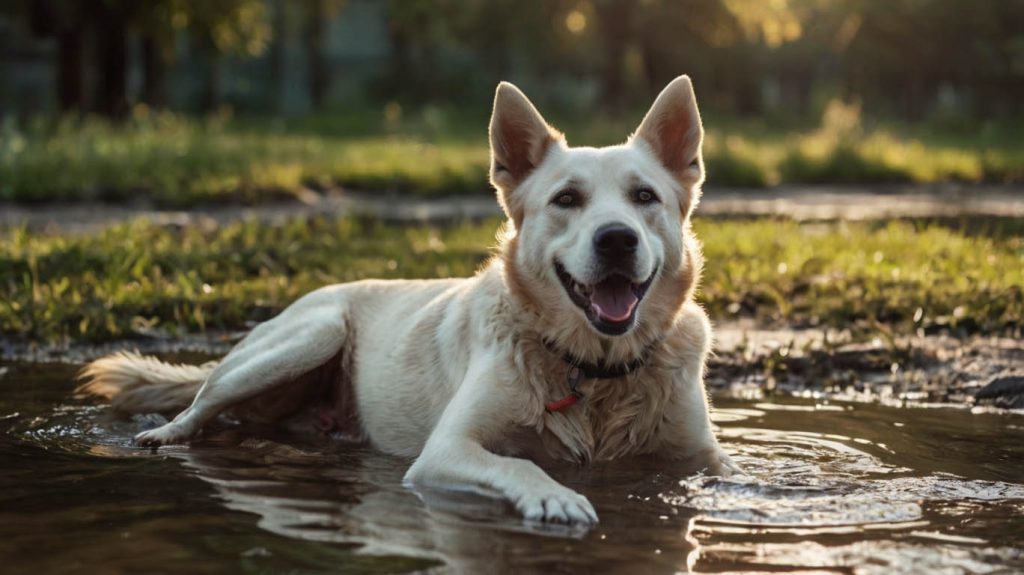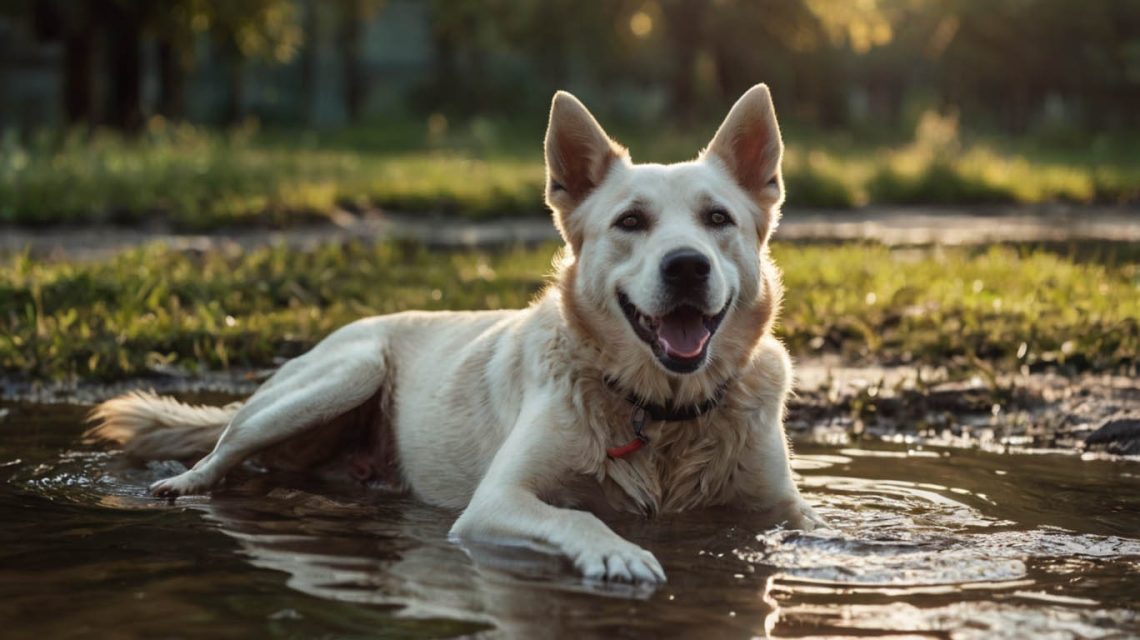Canine Dehydration: A Complete Guide to Recognizing the Symptoms and Protecting Your Dog
Mark and his energetic Border Collie, Luna, were inseparable. Their favorite weekend activity was hiking the local trails. On one surprisingly warm autumn day, they pushed a little farther than usual. Luna, as always, chased sticks and bounded through the underbrush with boundless joy. However, on the way back to the car, Mark noticed Luna’s pace had slowed considerably. She was panting heavily, and when he offered her water, she only took a few disinterested laps before flopping onto the ground. Mark initially thought she was just tired from their adventure. In reality, he was witnessing the first, subtle canine dehydration symptoms.
This scenario is far too common for dog owners. Dehydration in dogs is a serious and potentially life-threatening condition that can develop with alarming speed. Unlike humans, dogs can’t tell us they feel unwell or desperately thirsty. Therefore, the responsibility falls on us to recognize the signs.
This in-depth guide is designed to empower you with that knowledge. We will explore the unmistakable canine dehydration symptoms, uncover the common causes, and provide a clear, actionable plan. Consequently, you’ll be fully prepared to protect your four-legged family member from this silent threat.
The Importance of Identifying Canine Dehydration Symptoms
A dog’s body is approximately 80% water. This water is absolutely essential for every single biological function, from organ function to waste removal.
Water serves several critical roles:
- Thermoregulation: Panting is a dog’s primary way of cooling down, a process that expels a significant amount of water vapor.
- Nutrient Transport: Water acts as the superhighway of the body, carrying essential nutrients and oxygen to cells.
- Digestion and Absorption: It’s vital for breaking down food and absorbing its nutrients.
- Joint Lubrication: Water keeps joints cushioned and moving smoothly.
- Flushing Toxins: It supports the kidneys and liver in filtering and eliminating waste products from the bloodstream.
When a dog becomes dehydrated, these systems start to break down. Blood thickens, making it harder for the heart to pump. Organs become stressed as they struggle to function without adequate fluid. This can quickly escalate to kidney failure, heatstroke, and in severe cases, death. For this reason, prompt identification of canine dehydration symptoms is not just important—it’s a life-saving skill.

The Telltale Canine Dehydration Symptoms to Look For
Dehydration isn’t an all-or-nothing condition; it exists on a spectrum. The signs progress from mild and easy to miss, to severe and obviously life-threatening. Learning to spot them early is your best defense.
Early-Stage Canine Dehydration Symptoms
These are the initial signs that your dog is beginning to feel the effects of fluid loss. If you notice these, it’s time to intervene immediately.
- Lethargy or Reduced Energy Levels: This is often the very first sign. Is your normally playful dog suddenly tired, listless, or uninterested in their favorite activities? A sudden change in energy, especially following exercise or on a warm day, is a major red flag. This was the first sign Mark noticed in Luna.
- Dry Gums and Nose: A healthy dog’s gums and nose should be slick and moist. Gently lift your dog’s lip and touch their gums. If they feel sticky or dry, your dog is likely dehydrated. A dry, cracked nose can also be an indicator.
- Thick, Ropy Saliva: Instead of normal, thin saliva, a dehydrated dog may have thick, stringy drool hanging from its mouth. The body is trying to conserve water, resulting in more concentrated saliva.
- Loss of Appetite: Many dogs will refuse food when they feel unwell, and dehydration is no exception. If your dog turns its nose up at a meal or a favorite treat, it’s a sign that something is wrong.
Catching these early canine dehydration symptoms and providing water can often resolve the issue before it becomes a medical emergency.
Advanced Canine Dehydration Symptoms Requiring a Vet
If you observe the following signs, your dog’s dehydration has progressed to a moderate or severe level. This is a veterinary emergency.
- Sunken, Dull Eyes: This is a very serious symptom. As dehydration worsens, the fatty tissue behind the eyeballs shrinks, causing the eyes to appear sunken into the sockets. They may also lose their bright, clear appearance.
- Loss of Skin Elasticity: This is one of the most reliable at-home tests. Gently grasp the skin on your dog’s back, between the shoulder blades, and lift it up. In a well-hydrated dog, the skin will snap back into place instantly. However, if the skin “tents” and returns slowly, it is a definitive sign of dehydration. The longer it takes to return, the more severe the condition. This is a critical one of the canine dehydration symptoms to know.
- Delayed Capillary Refill Time (CRT): This simple test checks for poor circulation, a direct result of dehydration. Carefully press your finger on your dog’s gumline until it turns white. Release the pressure and count how long it takes for the pink color to return. It should be less than two seconds. A longer refill time indicates significant dehydration.
- Vomiting and/or Diarrhea: While these are often a cause of dehydration, their continued presence means your dog is in a dangerous cycle of fluid loss. They are losing fluids faster than they can possibly take them in.
- Weakness or Collapse: In the most advanced stages, a dog may become too weak to stand or may suddenly collapse. This indicates severe dehydration and shock, requiring immediate, aggressive veterinary intervention.

Common Causes Behind Canine Dehydration Symptoms
Understanding what causes dehydration is key to preventing it. The causes can be broadly divided into two categories: illness and environment.
Illness-Related Causes of Canine Dehydration
Often, canine dehydration symptoms are a direct result of an underlying medical issue.
- Gastrointestinal Illness: This is the leading cause. Conditions that cause vomiting and diarrhea, such as parvovirus, bacterial infections (like salmonella), or even dietary indiscretion, lead to massive fluid and electrolyte loss.
- Fever: An elevated body temperature increases a dog’s metabolic rate and water loss through heavy panting as the body tries to cool itself.
- Underlying Diseases: Chronic conditions like kidney disease, diabetes, and certain types of cancer can cause increased urination or an inability to properly regulate body fluids, leading to chronic dehydration.
Environmental and Behavioral Causes of Canine Dehydration
Sometimes, the cause is simply a matter of circumstance.
- Heat Exposure and Overexertion: This is a major risk, especially for active breeds. A dog playing or hiking on a hot day loses a tremendous amount of water. Without frequent water breaks, dehydration and heatstroke can set in quickly. This is precisely what happened to Mark and Luna.
- Inadequate Access to Water: This might seem obvious, but it can happen easily. A water bowl might be accidentally knocked over, become dirty, or simply run dry while you’re away from home.
Your Immediate Action Plan for Canine Dehydration Symptoms
Seeing these signs in your beloved pet is frightening. However, staying calm and following a clear plan is the best way to help them.
First-Aid for Mild Canine Dehydration Symptoms
If you’ve caught the dehydration early and the symptoms are mild (e.g., slight lethargy after a walk, sticky gums), you can take these steps.
- Get to a Cool Environment: Immediately move your dog into the shade or an air-conditioned room.
- Offer Small Amounts of Water: Provide a bowl of fresh, cool water. Encourage them to drink, but don’t force them. Offering small amounts frequently is better than letting them gulp down a huge volume, which could induce vomiting.
- Use Ice Chips: Many dogs are more willing to lick or crunch on ice chips than drink from a bowl. This is an excellent way to rehydrate them slowly.
- Consult Your Vet About Electrolytes: For mild cases, your vet may approve offering an unflavored pediatric electrolyte solution. Crucially, you must call your vet first to get their recommendation and the correct dosage for your dog’s weight.
Knowing When to Call the Vet for Canine Dehydration Symptoms
Your veterinarian is your most critical resource. Do not hesitate to call.
You must contact your vet or an emergency animal hospital IMMEDIATELY if:
- Your dog displays any of the advanced canine dehydration symptoms like sunken eyes or a slow skin tenting test.
- Your dog is actively vomiting or has diarrhea.
- Your dog refuses to drink any water at all.
- You suspect your dog has heatstroke.
- Your dog is a puppy, a senior, or has a pre-existing health condition.
- When in doubt, always make the call. A veterinarian can provide life-saving subcutaneous or intravenous (IV) fluids to rehydrate your dog far more effectively than you can at home.
Mark, realizing Luna’s condition was more than just tiredness, performed the skin elasticity test. The skin was slow to return. He immediately called his vet, who advised him to come in. The vet confirmed moderate dehydration and administered fluids. Because Mark recognized the canine dehydration symptoms and acted decisively, Luna made a full and rapid recovery.
Preventing Canine Dehydration: A Proactive Approach
The best way to treat dehydration is to prevent it from ever happening.
- Ensure Constant Access to Fresh Water: Your dog should always have access to one or more bowls of clean, fresh water.
- Bring Water on Outings: Always carry a portable water bottle and bowl on walks, hikes, or trips to the park.
- Manage Exercise in the Heat: During hot weather, restrict vigorous activity to the cooler parts of the day, such as early morning and late evening.
- Increase Moisture in Food: Adding a little water or a spoonful of vet-approved wet food to your dog’s dry kibble is an easy way to boost their daily fluid intake.
- Be Extra Vigilant During Sickness: If your dog is ill, especially with an upset stomach, monitor them closely for signs of dehydration and keep in close contact with your vet.
Your Dog’s Well-Being Is in Your Hands
Your dog trusts you completely. By learning to recognize the signs, understanding the causes, and knowing how to act, you are fulfilling that trust. Being vigilant about the canine dehydration symptoms is one of the most important things you can do to ensure your companion lives a long, happy, and healthy life.
Don’t keep this vital information to yourself. Share this guide with fellow dog owners to help them protect their pets. If you ever suspect your dog is dehydrated, your first and most important step is to contact your veterinarian immediately.


